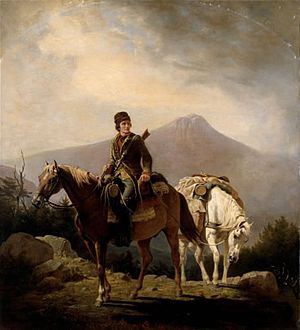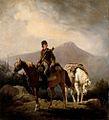Squire Boone facts for kids
Quick facts for kids
Squire Boone
|
|
|---|---|

An 1852 painting titled, "Squire Boone Crossing the Mountains with Stores for His Brother Daniel, Encamped in the Wilds of Kentucky"
|
|
| Born |
Squire Maugridge Boone Jr.
October 5, 1744 |
| Died | August 5, 1815 (aged 70) |
| Resting place | Squire Boone Caverns, Mauckport, Indiana |
| Other names | Squire Boone Jr. |
| Occupation | frontiersman, longhunter, soldier, city planner, politician, land locator, judge, politician, gunsmith, miller |
| Known for | Establishing the first American settlement in Shelby County, Kentucky and being the brother of Daniel Boone |
| Spouse(s) | Jane Van Cleave |
| Children | 5 |
| Relatives | Daniel Boone (brother) |
Squire Boone Jr. (born October 5, 1744 – died August 5, 1815) was an American frontiersman and a brother of the famous Daniel Boone. A frontiersman was someone who explored and lived in the wild, unsettled parts of the country. Squire Boone was also a soldier, a city planner, and a gunsmith.
In 1780, he started the first settlement in Shelby County, Kentucky. Squire was the tenth of eleven children born to Squire Boone Sr. and Sarah (Morgan) Boone. Even though his brother Daniel was more famous, Squire Boone was well-known during his time.
Contents
Early Life and Family
Squire Boone Jr. was born in Berks County, Pennsylvania, on October 5, 1744. His parents were Squire Boone Sr. and Sarah Jarman Morgan. In 1749, when he was five years old, his family moved. They settled in the Yadkin Valley in Rowan County, North Carolina.
When Squire was 15, he went back to Pennsylvania. He became an apprentice to his cousin, Samuel Boone, to learn how to be a gunsmith. This means he learned how to make and fix guns. After five years, he returned to North Carolina. On August 8, 1765, he married Jane Van Cleave. They had five children together.
Adventures in Kentucky
From 1767 to 1771, Squire Boone went on several "long hunts" with his brother Daniel. A long hunt was a trip where hunters would stay in the wilderness for many months. They explored the wild lands of Kentucky.
In 1775, a judge named Richard Henderson hired Daniel Boone. Daniel's job was to create a path through the wilderness. This path became known as the Wilderness Road. It went through the Cumberland Gap and into central Kentucky. Squire Boone joined his brother and about 30 other people. They helped to build a settlement called Boone's Station.
Challenges and Injuries
In the spring of 1779, Squire Boone was hurt during a fight. This fight was called the siege of Boonesborough. A rifle ball hit his shoulder, and doctors had to remove it. After he recovered, he moved his family to a new settlement. This place was at the Falls of the Ohio, which later became Louisville.
In 1780, Squire Boone led 13 families to a piece of land called "Painted Stone." Here, he started Squire Boone's Station. This was the first lasting settlement in Shelby County. In April 1781, Native Americans attacked the fort. Squire was shot again. This injury was serious, and his right arm ended up being shorter than his left.
On September 13, 1781, the settlers at Squire Boone's Station had to leave. There were not enough people to defend the fort. They headed for a nearby place called Linn's Station. Squire Boone was still weak from his injury. He stayed behind at the station with his family and one other person. The settlers who left were attacked in what became known as the Long Run massacre.
Later Work in Kentucky
In 1782, Squire Boone started working as a land locator. He helped rich people find and claim land on the frontier. These wealthy people did not want to risk living in the wild themselves. However, Squire lost money in this job. By 1786, he lost his own land, including his station. He had to move to another part of the county.
Squire Boone also became a politician. He served two terms in the Virginia legislature in 1789 and 1790. He helped create a law to officially establish the town of Louisville.
Life in Indiana
Squire Boone tried to start a settlement near what is now Vicksburg, Mississippi. He also lived with his brother Daniel in Missouri for a few years. Around 1804, he finally settled with his family in Harrison County, Indiana. This area is now called Boone Township.
Squire bought a large piece of land near a cave. He and his brother had once hidden in this cave to escape Native Americans. Squire thought the cave was a special place. He decided he wanted to be buried there when he died.
On his land, Boone built his home using stone from a nearby hill. He carved religious and political messages into the quarry wall. These carvings can still be seen today. Squire also built Old Goshen Church, which was one of the first churches in Indiana. He became an important person in the area and served as a Justice of the Peace in 1808.
Death and Burial
Squire Boone died on August 5, 1815, at the age of 70. He passed away from a heart problem. He was buried inside the cave on his property, just as he wished.
For many years, his burial place was left alone. But in the mid-1900s, people looking for old items started taking parts of his coffin and even some of his bones. To protect his remains, in 1973, his bones were moved. They were placed in a new coffin inside the commercial cave, which is now known as Squire Boone Caverns. You can see his coffin there today at the end of the cave tour.
Images for kids
See also
 In Spanish: Squire Boone para niños
In Spanish: Squire Boone para niños




